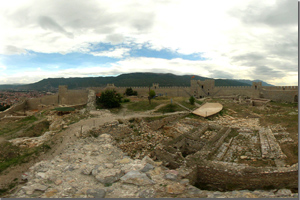|

 1.0 MB 1.0 MB
Samuel's Fortress
The earliest historic records of the Ohrid Fortress is its mention by the classical historian Livius in the III century B.C., when it was the fortress of the town of Lychnidos. The chronicler Malcus (Malala) gives the earliest more detailed description of the fortress, in 478 A.D.
The Ohrid Fortress of Tzar Samuel was described by the chronicler as a mighty stronghold that even Theodoric, King of the Ostrogoths, was unable to seize. The Ohrid Fortress is one of the largest preserved fortifications in the Republic of Macedonia. Its massive ramparts and towers surround the entire summit of the hill of Ohrid. The highest part of the town was protected on all sides save the southern, which faces the lake, by towers and high walls three kilometres long, stretching as far as the quay.
The town was entered by three gates, of which only the Upper Gate has been preserved.
The Fortress both served as a defence against enemies and an inhabited area known as Samuel's Fortress.
During the rule of Samuel (976-1014), and of his successors, up to 1018, Ohrid was the capital of the first state of the Macedonian Slavs.
Both before and after Samuel's time and that of his successors, the Fortress was destroyed and rebuilt.
After the transformation of Samuel's state into a political and ecclesiastical seat, Ohrid became a medieval metropolis.
In the letters of Theopilact, Bishop of Ohrid, there are several pieces of information about the shape and the life of Ohrid towards the end of the XX and the beginning of the XII century, when it was a big medieval town.
Within the walls there were numerous streets with a large number of several-storeyed buildings and narrow wooden houses. The town continued to dominate next to its Fortress, a true acropolis.
Up to the late XIV and early XV centuries, the inhabited town of Ohrid lived within the town ramparts. After its seizure by the Ottomans, the arrival of Asia Minor colonists in the XV century led to its expansion to the lower parts. The Christian population remained within the town walls. Thus, as an appendix to the Upper Town on the hill, the Lower Town developed on the lower sections around the hill.
|
|
|
|
|